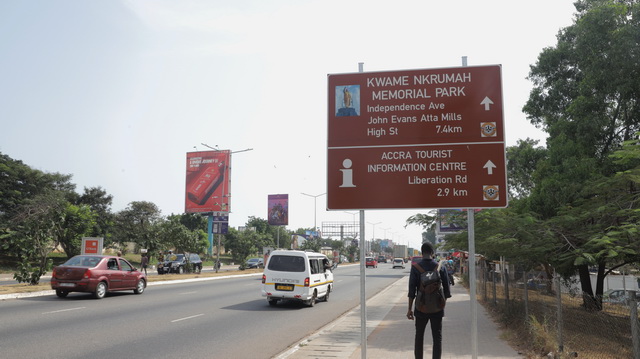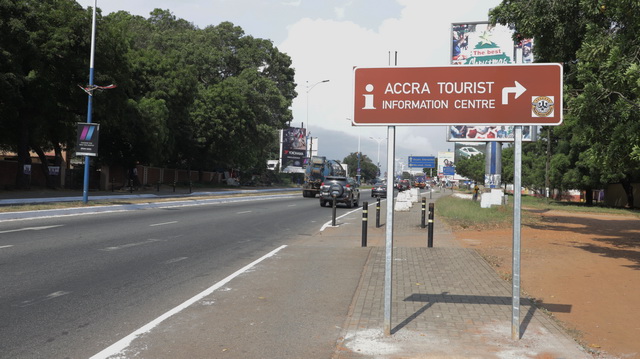
Have you noticed the changing face of tourist directional signs in Ghana?
The tourism industry in Ghana has long been identified as one of the key drivers of national economic transformation. The sector has an important role to play in placing the Ghanaian economy on a sustainable inclusive growth trajectory.
Described as the “New Gold”, it is a sector that is thriving, and that has tremendous potential for further growth and for the creation of much-needed jobs.
Advertisement
But many visitors to beauty spots and other places of interest in Ghana complain about the difficulty of finding what they look for.
This frustrations are compounded by bad roads and the lack of directional signs that make the trips unnecessarily long and arduous.
Fixing roads leading to tourist sites is a big challenge – and it is as if we have deliberately refused to place premium on this sector with ‘low hanging fruits.’
Overcoming the lack of signage however, is something that can be remedied with very little state expense if tourism initiatives such as the Year of Return are properly harnessed.
Destination managers invest a lot in marketing and promoting tourism facilities but often fail to think about the importance of good signage to the sites.

To ensure that tourism benefits the local community and the local economy, visitors to such areas need to be given appropriate directions to easily locate attractions, amenities and services.
It is no good trying to develop tourism in a big way if foreigners and domestic tourists cannot find what they are looking for.
I recall when I first went to the Kalakpa Game reserve at Abutia Kloe in the Volta Region with my very experienced driver George. He seemed to know every corner of the country from Aflao to Elubo and from Paga to Accra.
George certainly is familiar with places of interest in Ghana, yet he drove past the turnoff point for Kalakpa Reserve on the Ho-Adidome road and proceeded for some kilometres before one of our companions, who had previously been there, wondered out-loud if we had gone too far.
It is often difficult to find a clean pathway to many of these places hence it is demotivating for tourists who may not return or even recommend the destination to family and friends.
Visitor’s signage
Visitor’s signage is a key part of destination marketing and management.
A signage has many functions - it can attract visitors, provide direction, inform, and educate. It also plays a critical role in linking visitors to the “product” or experiences within an area.
I have spotted the first white-on-brown tourist signs on the Liberation road near “Opeibea House” and another one at the Ako-Adjei Interchange close to the Accra Tourist Information Centre with the logo of the Ghana Tourism Authority embossed on it.
This good signboard that direct visitors to the Accra Tourist Information Centre is an important starting point and it is the way to go! Congratulations, GTA.
In developed tourism destinations, brown signs are erected to guide visitors to a pre-selected destination along the most appropriate routes of their journey, particularly where destinations are difficult to find.
Like any form of traffic signage, tourist signs are only an aid to safe and efficient navigation, which complement, but cannot replace pre-planning material such as maps and atlases.
A large percentage of visitors do some degree of research regarding a destination before they leave home, via brochures, directories, advertisements and, most prominently, via the internet.
Increasing numbers especially among younger age groups conduct their research ‘on the road’, or at the destination, via smart phones and other hand-held devices.
However, despite this increasing use of hand-held information devices, a significant proportion of visitors still make use of a Visitor Information Centre, or, when not available, maps, among others.
The case of Ghana
Unfortunately, in Ghana it is not common to see signs to key monuments, shrines, ancient towns, relics of forts, castles, and ancient pre-colonial buildings whose stories are tied up to our history as a people.
Can you imagine the economic benefits of driving traffic to Dodowa with the aid of Brown Signs?
Although there is no proper visitor receptive facility, local guides will earn a living escorting tourists to the Tsenku Waterfalls, also called Wuruduwurudu Falls located in the Dodowa Forest while educating them on the famous battle-field of the Kantamanso War which ended in 1826.
Effective tourism signage have benefits for visitors and the community. They provide opportunities for the area and promote interactions between visitors and the local community.
For example, signs might direct visitors to the centre of the town where local businesses might benefit from the visitors and visitors also benefit from talking to locals about what they offer.
I hope the “white-on-brown” sign project will be rolled out nationwide to provide seamless experiences in connecting all tourists attractions in the country.




